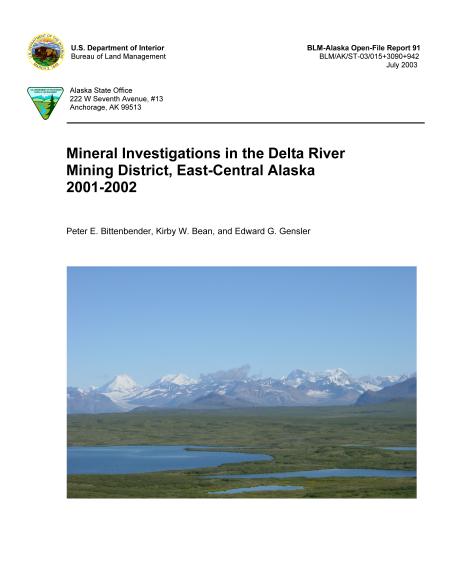Mineral Investigations in the Delta River Mining District, East-Central Alaska, 2001-2002

In 2001 and 2002 Bureau of Land Management (BLM) investigators surveyed, mapped, or sampled 108 mineral occurrences in the 2.9-million-acre Delta River Mining District, which extends across the Alaska Range from Paxson to Delta Junction, in east-central Alaska. The BLM collected and analyzed 487 rock chip, placer, pan concentrate, and stream sediment samples during the investigation. In addition, the BLM had 264 U.S. Geological Survey (USGS) stream sediment samples analyzed by the inductively coupled argon plasma – atomic emission spectroscopy (ICP-AES) technique for 40 elements and by fire assay, atomic absorption finish, for gold, platinum, and palladium. A subset of 17 of these samples, all with high nickel values, was analyzed for the full suite of platinum group elements (PGE). The BLM is scheduled to complete fieldwork for the mineral assessment program in the district in 2004 and will produce a final report in 2005.
Noteworthy results from the BLM’s investigations include the discovery of PGE-bearing disseminated and net-textured sulfides hosted in gabbro and peridotite in the Cony Mountain area, in the eastern part of the district. Also, a pan concentrate sample from the Chisna River area returned 792 ppm gold and 2.29 ppm platinum. Investigators have not positively identified platinum lode sources in the Chisna River area to date.
The BLM coordinated the collection of gravity, magnetic, and magnetotelluric data by the USGS in the district in 2001 and 2002. Modeling of these data indicates the potential for a dense, moderately magnetic, strongly conductive body oriented approximately along the axis of a synform in the Amphitheater Mountains, in the southern part of the district.
The University of Alaska, Fairbanks, determined an early Late Triassic Ar/Ar age date of 228.3 + 1.1 million years, on a sample of phlogopite in gabbro from the PGE-bearing Rainy Creek mafic-ultramafic complex in the district. This age correlates a tectonically dismembered mafic-ultramafic complex north of the Rainy Creek thrust fault, that may have been intruded at a deeper stratigraphic level, with possibly shallower, generally undeformed complexes to the south, dated at 230.4 + 1.3 million years.
In 2002, the BLM contracted an airborne geophysical survey in the southwestern part of the district. The survey, administered by the State of Alaska, Division of Geological and Geophysical Surveys, collected aeromagnetic and three frequencies of resistivity data across approximately 350 square miles. The primary target of the survey was copper-nickel-PGE-bearing mafic and ultramafic rocks. The survey products released to the public in March, 2003 include approximately 250 square miles of aeromagnetic and resistivity data previously purchased by the BLM.
